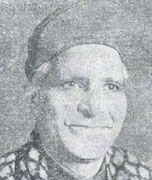Parmanand (1791-1879)
by
Prof. P. N. Pushp
 Parmanand
rose to enviable eminence not only as a
saint, but also as a poet articulating spiritual
insights. Born in the family of a village Patwari
he was named Nanda or Nanda Ram, and his
persistent endeavour transformed him into
Parmanand (Parma Ananda, i.e. Supreme Bliss)
His father, Krishna Pandit, belonged to the
village Seer, about three kilometers away from
Mattan where he was working as Patwari. His
mother, Sarswati, was a pious lady thoroughly
conversant with the spiritual heritage of the
community, despite her illiteracy. Parmanand
rose to enviable eminence not only as a
saint, but also as a poet articulating spiritual
insights. Born in the family of a village Patwari
he was named Nanda or Nanda Ram, and his
persistent endeavour transformed him into
Parmanand (Parma Ananda, i.e. Supreme Bliss)
His father, Krishna Pandit, belonged to the
village Seer, about three kilometers away from
Mattan where he was working as Patwari. His
mother, Sarswati, was a pious lady thoroughly
conversant with the spiritual heritage of the
community, despite her illiteracy.
Parmanand
received his formal 'schooling' in a Maktab where
he was given a smattering of rudimentary Sanskrit with
a working knowledge of the Persian courses
deemed essential for a prospective patwari.
Persian was, those days, not only the language of
administration but also the language of cultural
transmission of even the Sanskritic lore,
including religion and philosophy, astrology and
ritualistic tracts. Parmanand availed of this
traditional facility too as is obvious from the
copy of the (Persian) Upanikhat left by him. Yet,
it was the live contact of Nand Ram with the
saints and spiritual aspirants at Mattan and
around that deepened his longing for
self-realization not withstanding the demands of
his profession, and the resentment of his
ambitious wife Maalded. She was the daughter of a
succesful patwari and naturally expected her
husband to make hay while the sun shone.
Parmanand
braved the stress and strain of the times, and
persisted in his Sadhana under competent guidance
of a genuine Paramahamsas. His admirers like Saleh
Ganai, the Zailder of Mattan, looked after his
material needs and provided him a congenial
atmosphere for spiritual preoccupation, so that he
could articulate his aspiration as well as
realization. In his utterance we therefore, find
the unfolding of a variety of spiritual layers.
During the Amarnath pilgrimage days he had
witnessed the multidimensional manifestation of
spiritual quest at Mattan and had realized the
need to "proceed from the (external) cave to
the personal cave (within)' and to face the
selfless Self, meditate on the Sahaja (In boro
Truth)." The interplay of the individual Soul
and the Cosmic Soul was for him a Leelaa (sport of
the Spirit) which he presented variously in his
verse, particulary in his three Leelaa poems,
Shiva-Lagan (Siva's Wedding), Raadaa-Svayamvar (Radha's
Choice of Her Own Man) and Sodaam- Tsareth (Sudama's
Story).
The
allegorical nuance has all through remained
unobtrusive yet significant, within the convincing
depiction of personal and interpersonal contours
of social behaviour such as: parental solicitude
to see the daughter suitably married away, and the
girl's ambition to secure the boy of her own
choice Parmanand has thus achieved remarkable
success weaving the Pauranic legends into
contemporary realities of pervasive import
artlessly harmonized with the allegorical
significance, such as in the following rendering:
"Gokul
is my heart wherein thrives the pasture of your
kine;
O
Lord, shining in consciousness !
Mindways
are the Gopi's running reckless after you;
maddened
by the call of Krishna's flute,
Losing
sentience and feeling, forgetting self and
non-self...."
Parmanand's
Raasleelaa (in his Raadaa Svayamvar) symbolizes
the universal dance of cosmic consciousness,
integrating the secular with the spiritual:
"Wandering
all around they find him at no point,
they
hear from far away the flute alone.
None
plays there with anyone else,
none
but Krishna there; Krishna alone, cowherd lads
and lasses,
men,
women, none is there who is not He
....
Trees and plants and stones with eyes agape
unravel secrets of the inner depth."
The
Shiva-Lagan, similarly signifies the union of
Shiva and Shakti at both the immanent and the
transcendental levels; while the Sodaam-Tsarete
reflects the unshakable ties between the Oversoul
and the individual soul, in the ideal friendship
of Krishna and Sudama. Similar concern with the
essential rather than the ephemeral reverberates
in the smaller poems of Parmananda, and quite a
number of them sound as spiritual rhapsodies
over-flowing with spontaneous lyricism. He left
the Kashmiri language positivity richer than he
had found it.
| 